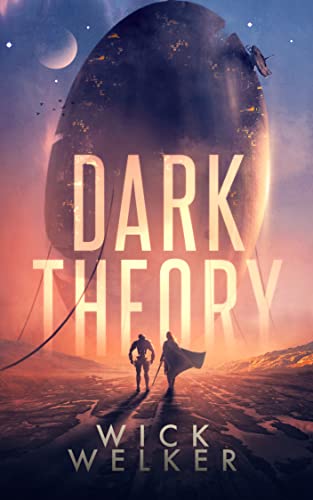Wick Welker’s Dark Theory (the first volume of a series called Dark Law) poses basic questions about what it means to be human in a far-future poisoned world. The story begins in a junkyard where people have to scavenge the means of survival. Two young women, the generous-hearted Lucindi and the hardened and cynical Miree, discover a broken robot. Largely due to Lucindi’s kind concern, they dig out the bot and revive him rather than break him apart for his valuable components.
Self-aware, short in stature and made of a mysterious blue metal, he remembers only his name, Beetro, and his mission, to find Galiaro, who, he thinks, must be his maker. Welker creates a moving portrait of human decency and kindness in these opening pages, but those qualities are quickly threatened by the brutal reality of the power-hungry General Deluvius and his massive invading army. Whether or not these characters can survive in a crushing world where they constantly question who they are is a beautifully wrought theme of Dark Theory. This is a strong start to a fascinating series.
Beetro and his companions set out to find Galiaro on a journey that could come straight out of a fantasy novel. They have to cross plains full of radiation-poisoned water, navigate forests of trees that kill humans, confront a menacing cyborg group called the Reticulum, climb precipitous mountains, and cross a dangerous sea on their way to the city of Orion.
Dark Theory alternates sections about these characters with the story of a very different man named Armyn. He lives in an underground community called the Crib, which was founded by a man so horrified by the conflict and destruction on Earth that he disappeared into an underground world. Over many years, he built a whole community of men (only) who constructed a deep underground habitat to escape radiation poisoning and the culture of war.
Though raised in its traditions of secrecy and avoidance of the “overworld”, Armyn regularly gets out of the Crib for excursions in a nearby valley but can’t bring himself to make a permanent break. Until, that is, he meets a strange and beautiful person unlike anyone he knows underground. This woman (of course Armyn doesn’t know what a woman is since his society is male only) learns to speak enough words of his language so that she can communicate a little about her origin. This is Hawera who comes from the future and is searching for ancient technology that can set time right and avoid disaster for her people. When Deluvius’ army starts attacking the Crib, Armyn and Hawera have to flee to find help.
These characters and their different missions come together after perilous journeys in Orion. This strange city is shaped like a giant egg and made of the same mysterious metal as Beetro. The city is one of many artifacts left behind by the legendary Alchaens, a human race that became so advanced they disappeared into a different dimension of reality. They also left stores of advanced weaponry and other technology that humans no longer know how to produce but are eager to find and use. Like Spearpoint in Terminal World, Orion has ledges cut into its sides where whole districts of the city have been built. But much of Orion has been taken over by a murderous gang called the Kish, and the whole structure is soon surrounded by Deluvius’ merciless army.
While all that is going on, Welker brings in lots of intriguing science about dark matter and dark energy and a theory about how the accelerated expansion of the universe has caused the stars to vanish from the night sky. All that can be seen are five planets, and when one of them, Saturn, suddenly disappears (meaning it has been flung out of its orbit) the distortions on Earth, which moves closer to the Sun, mean the real end of the world is fast approaching. So it is crucial that Beetro and company solve the mystery of how the Alcheans escaped this dimension.
Throughout their journeys the main characters face hard moral choices: to aid strangers or to fight them, to share knowledge and possessions or to hide them, to use power to help others or to attack them. And each main character has an arc, usually through a lot of pain, emotional or physical, to learn how to survive in a collapsing world without losing all humanity.
It is Beetro who has to face the greatest challenges. As he tries to regain his memory, he learns he may not be the decent, caring person he seems to be but rather a dangerous and power-hungry force for evil. This seems preposterous to him, but he does have these strange dreams of a vast army turning to him for guidance. Welker draws you in to find out how Beetro and the others will respond to the violent tests of their humanity.
Dark Theory is full of intriguing science fictional explanations of impossible phenomena and lots of advanced technology, but the story blends in lots of many elements of fantasy. Welker makes that work quite well, but the way he has structured the book takes us through some repetitive scenes and stretches everything out just a bit too much. At over 800 pages, the novel brought out my editorial mind. Surely, you could cut this, combine those, shorten the whole thing and only improve a very good story. So it can feel like a slog at times, and that’s unfortunate because I really like this book, with its quirky characters, wild science and bristling landscapes. I just thought a serious trimming down would have improved the whole thing.
My thanks to the author and NetGalley for an advance review copy on which to base this review, consisting solely of my own opinions.





Leave a Reply